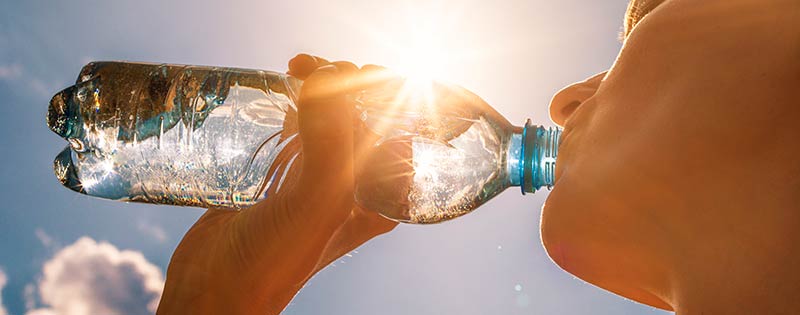by Brent Hearn •
The bad news: The weather didn’t get the memo. In a summer that’s featured record-breaking heat waves all across the country, it’s still hot enough to fry an omelet on the sidewalk in many places. (Helpful hint: If you’re going to do any omelet-frying, it’s less than sanitary to place the eggs directly on the sidewalk—and less than polite not to invite me to your sidewalk for breakfast.)
The especially bad news: Extreme heat can be more than annoying; it can be dangerous or even deadly. It’s important to know the symptoms of various heat-related illnesses and how to treat them.
Heat Rash
Heat rash refers to the clusters of red blisters that can develop on areas of the body where sweat gets trapped (inside the elbows, behind the knees, etc.) You can treat heat rash—also known as prickly heat—by moving from the heat to a cool, dry place and by keeping the rash dry. Baby powder and other similar products can be used to soothe the rash.
Sunburn
Overexposure to the sun can cause a sunburn, which is characterized by painful, red, and warm skin. Sunburn can affect any area of your body exposed to the sun. (Even covered areas can burn if the fabric has a loose weave.) A mild sunburn can be annoying and uncomfortable. A severe sunburn can be extremely painful and dangerous. Intense, repeated sun exposure that leads to sunburn can increase the risk of skin cancer and other disorders.
To prevent sunburn, limit exposure to the sun, especially during the hottest part of the day, and use sunscreen—the higher the SPF, the better. Place a cool cloth on sunburned skin or take a cool bath and apply moisturizer. If the sunburn results in blisters, don’t pop them.
Heat Cramps
Heat cramps are a result of dehydration and loss of nutrients from excessive sweating. Look out for heavy perspiration and muscle pain/spasms during intense exercise. Heat cramps are most common in the abdomen, back, arms, or legs.
If you experience heat cramps, stop the strenuous physical activity, and move to a cool place. Drink water and a sports drink, and don’t resume exercise until the cramps are gone. If cramps last longer than an hour, if you have heart problems, or if you’re on a low-sodium diet, seek medical attention right away.
Heat Exhaustion
Heat exhaustion is more serious than the heat illnesses listed thus far. It occurs when your body has overheated and can’t cool itself down. Symptoms include dizziness, nausea, headaches, and muscle cramps (among others). If untreated, heat exhaustion can lead to heatstroke.
If you’re suffering from heat exhaustion, move to a cool place; loosen your clothes; place cool, wet cloths on your body or take a cool bath; and sip water. Seek medical attention immediately if you’re vomiting, your symptoms worsen, or if your symptoms last longer than an hour.
Heatstroke
Heatstroke is very serious and can lead to organ damage or death. Symptoms include a body temperature of 103 degrees or higher; hot, red, dry, or damp skin; a fast, strong pulse; headaches; dizziness; nausea; confusion; and loss of consciousness.
Time is of the essence with heatstroke; the longer a person goes without treatment, the more the damage can worsen. If you experience symptoms of heatstroke or see them in others, call 911 immediately. Move the person to a cool place and take measures to lower their body temperature rapidly however you can. (For example, you could apply cool cloths to their skin, apply ice packs to their groin and armpits, or apply cool water to their skin and fan them to simulate sweating.) Do not give them anything to drink; they could have an altered state of consciousness and be unable to safely swallow.
In Conclusion…
Fun in the sun is all well and good, but it’s better to be safe than sorry! If you’re experiencing symptoms of heat illness, get out of the sun and get somewhere cool. For a comprehensive, easy-to-reference list, check out the CDC’s Warning Signs and Symptoms of Heat-Related Illness.
Sources:
- Record-breaking U.S. heat wave bakes Americans
- Warning Signs and Symptoms of Heat-Related Illness
- What Are The Dog Days Of Summer?
- The Difference Between Heatstroke and Heat Exhaustion, and How to Treat Both
- Sunburn: Symptoms & Causes
- Heat Cramps
- Heat Exhaustion
- Heatstroke
- Dehydration and Heat Stroke
- Emergency First Aid for Heatstroke









 ▶︎
▶︎  Why is the Discount Challenge prize amount $15,024? Because that is the average “per-occurrence” fine for Medicare inducements. That’s not $15,024 per patient, that’s not per provider, that’s PER VISIT. Stinks, doesn’t it? To us, the prize amount is worth the investment if we can help our profession better understand proper discounting.
Why is the Discount Challenge prize amount $15,024? Because that is the average “per-occurrence” fine for Medicare inducements. That’s not $15,024 per patient, that’s not per provider, that’s PER VISIT. Stinks, doesn’t it? To us, the prize amount is worth the investment if we can help our profession better understand proper discounting.